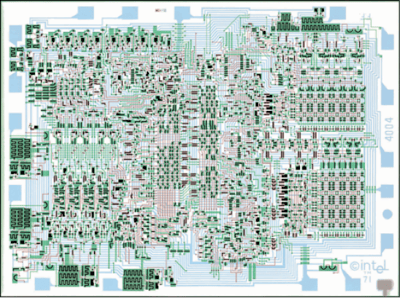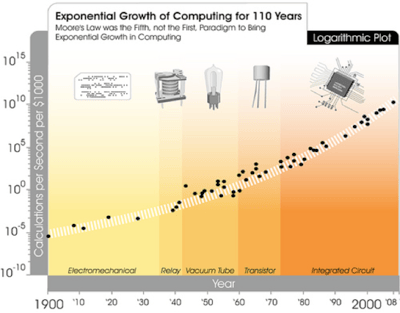
No doubt you've heard of Moore's Law.
What you might not realize is that Moore's Law only refers to the exponential price-performance improvements of integrated circuits (over the last 50 years).
Did you know that exponential growth has been going on for a much longer period? Or that such growth is occurring in other fields outside of computing, such as communication and genomics?
Such exponential growth is actually described by "The Law of Accelerating Returns," a term coined by my friend and Singularity University Chancellor/Co-founder Ray Kurzweil.
This blog aims to explain the difference between Moore's Law and the Law of Accelerating Returns – an important distinction to understand for the exponentially minded.
P.S. Send any tips to our team by clicking here, and send your friends and family to this link to subscribe to Abundance Insider.
What is Moore's Law?
In 1965, Gordon Moore (a founder of Intel) published a paper observing that between 1958 and 1965, the number of transistors on an integrated circuit have been doubling roughly every 18 to 24 months. He projected this would continue for some time. This concept has held true for 50 years and is known as "Moore's Law."
To get a gut feeling of Moore's law, let's look at the physical evolution of the microchip. In 1958, a scientist at Texas Instruments developed the first-ever integrated circuit. It had two transistors (the more, the better) with a "gate process length" (the smaller, the better) of about ½ inch. This scientist would go on to win the Nobel Prize.

The first integrated circuit in 1958
Now, fast forward 13 years.

The Intel 4004 Integrated Circuit
In 1971, Intel came out with its first commercial product, a 4-bit CPU called the Intel 4004 integrated circuit. The 4004 had 2,300 transistors with a gate length of 10,000 nanometers, and computer power of about 740 KHz.
By this time, each transistor cost about $1, on average.
Now fast forward another 40 years…

2012 GPU from Nvidia
In 2012, Nvidia released a new graphical processor unit (GPU) with 7.1 billion transistors, a gate length of 28 nanometers, and processing power of 7GHz.
The cost of a transistor: ~ $0.0000001
In just 40 years, the technology experienced a 100 billion-fold improvement, right on schedule for Moore's Law.
The Law of Accelerating Returns
But Moore's Law only describes the latest period (the 5th paradigm) of computational exponential growth.
As Ray Kurzweil described in his most excellent book, The Singularity Is Near, exponential growth in computation has existed for over a century, and has gone through five different paradigms of exponential growth:
- 1st Paradigm: Electromechanical computers
- 2nd Paradigm: Relay-based computers
- 3rd Paradigm: Vacuum-tube based computers
- 4th Paradigm: Transistor-based computers
- 5th Paradigm: Integrated circuits (Moore’s Law)
Moore's Law (the 5th paradigm of computation) is therefore a subset of a much broader exponential principle described by Kurzweil's Law of Accelerating Returns.

Graphic from Singularity is Near, demonstrating "Law of Accelerating Returns" in the field of computation
It's important to note that Ray recently mentioned to me that the sixth paradigm – three-dimensional computing – is already underway.
Why is Technology Accelerating?
It is important to understand the underlying drivers for the Law of Accelerating Returns. Why is technology accelerating? As Ray references, "We won't experience 100 years of progress in the 21st century — it will be more like 20,000 years of progress (at today's rate)".
Here's the basic reasoning:
- Evolution (biological or technological) results in a better next-generation product. That product is thereby a more effective and capable method, and is used in developing the next stage of evolutionary progress. It’s a positive feedback loop.
- Put differently, we are using faster tools to design and build faster tools.
- In biological evolution, the more advanced life form (think cellular) is able to gather energy and reproduce more effectively, and therefore outperforms and out-evolves other life forms.
- As a result, the rate of progress of an evolutionary process increases exponentially over time, and the “returns” such as speed, cost-effectiveness, or overall “power” also increase exponentially over time.
- As a particular evolutionary process (e.g., computation) becomes more effective (e.g., cost effective), greater resources are then deployed toward furthering the progress of that process. This results in a second level of exponential growth (i.e., the rate of exponential growth itself grows exponentially).
Is Biology & Life Advancing Exponentially?
To paraphrase Kurzweil… The Law of Accelerating Returns also explains exponential advancement of life (biology) on this planet. Looking at biological evolution on Earth, the first step was the emergence of DNA, which provided a digital method to record the results of evolutionary experiments. Then, the evolution of cells, tissues, organs and a multitude of species that ultimately combined rational thought with an opposable appendage (i.e., the thumb) caused a fundamental paradigm shift from biology to technology. The first technological steps -- sharp edges, fire, the wheel -- took tens of thousands of years. For people living in this era, there was little noticeable technological change in even a thousand years. By 1000 A.D., progress was much faster and a paradigm shift required only a century or two. In the 19th century, we saw more technological change than in the nine centuries preceding it. Then in the first 20 years of the 20th century, we saw more advancement than in all of the 19th century. Now, paradigm shifts occur in only a few years' time. The World Wide Web did not exist in anything like its present form just a decade ago, and didn't exist at all two decades before that. As these exponential developments continue, we will begin to unlock unfathomably productive capabilities and begin to understand how to solve the world's most challenging problems. There has never been a more exciting time to be alive.
WHAT IS ABUNDANCE INSIDER?
This email is a briefing of the week's most compelling, abundance-enabling tech developments, curated by Marissa Brassfield in preparation for Abundance 360. Read more about A360 below.
WANT MORE CONVERSATIONS LIKE THIS? - JOIN ME
At Abundance 360, Peter's 360-person executive mastermind, we teach the metatrends, implications and unfair advantages for entrepreneurs enabled by breakthroughs like those featured above. We're looking for CEOs and entrepreneurs who want to change the world. The program is highly selective. Apply now for Abundance360 Summit if you'd like to develop an Abundance Mindset.
Know someone who would benefit from getting Abundance Insider? Send them to this link to sign up.







